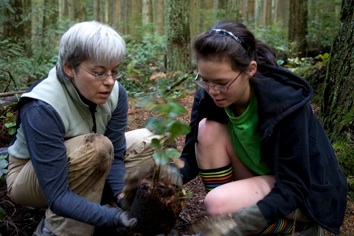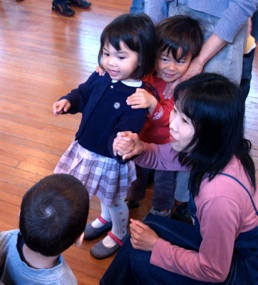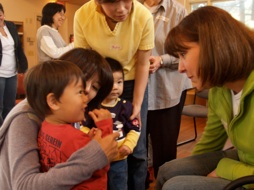con-versare “turning together”


we grow up in conversations
From the moment of its conception the child lives immersed in the languaging and emotioning of its mother and of other adults and children that constitute its surroundings of coexistence during pregnancy and after birth. The result is that as an embryo, fetus, child or adult, a human being acquires his or her emotioning in his or her ongoing existence which is congruent with the emotioning of other beings, human or non-human, with whom he or she lives. We would normally say that the child learns to emotion him/herself in different manners as a human being to the emotioning of other adults and children (and other animals) that constitute his/her human and non-human surroundings and will be cheerful, touched, embarrassed, angry… according to the contingencies of the circumstances in which its peers become cheerful, touched, embarrassed, angry… etc. Since this process happens in every new human together with the constitution and expansion of the domains of consensual coordinations of behavior in which he or she participates -- at first until these domains become recursive and he or she starts to operate in language, and later in the expansion of insofar as he or she amplifies and complexifies his/her living in language -- languaging and emotioning interbraid themselves in a mutual modulation as a simple result of this coexistence with others in a path which is contingent with this coexistence. When we move within language in interactions with others, our emotions change according to an emotioning which is the function of the history of interactions that we have lived and in which our emotioning emerged as an aspect of our coexistence with others outside and inside languaging. At the same time, with the flow of our emotioning in a path that has resulted from our history of common life inside and outside language, we change our domain of actions and, therefore, the path of our languaging and of our reasoning changes. This interbraided flow of languaging and emotioning I call conversing and I call conversation the flow of conversing within a particular network of languaging and emotioning.
Maturana, The Ontology of Conversing
etymology, again
The word “conversation” derives from two Latin roots; namely com meaning “together” and versare meaning “to turn.” Hence it literally means “turning together” - perhaps a daily life understanding of structural coupling.
So what are the implications.. both in terms of individual lives, and what we do together? What does conversation have to do with human evolution, with child development, and the manners we interact with each other in whatever we do? These are the questions addressed in this Unit.
about conversations
There are many books on conversation. Furthermore, the SelfDesign approach to conversation is well developed. In this unit I do not wish to presume that I have much to say about it. I will however provide you with what I do know and like, namely Maturana’s perspective.
For one thing, his perspective is coherent with both SelfDesign and with everything else in this course. We humans beings live as human beings in languaging and emotioning, and together these constitute the flow of conversations. Thus we live as humans in a flow of conversations.
we evolved in conversations
In short: the human appears in the evolutionary history to which we belong when language appears, but it constitutes itself in fact and as such in the conservation of a particular manner of living centered around the sharing of food, the cooperation of males and females in the upbringing of children, the individualized recurrent sensual encounters, conversing, and around the pleasure of living in conversing. Because of that every human activity departs from an emotion, and nothing human occurs outside the interbraiding of languaging and emotioning and, therefore, the human is lived always in conversing. Finally, the emotioning in which the conservation of the human is constituted when language appears is centered around the pleasure of coexistence in the acceptance of the other close to oneself, that is, in love, which is the emotion that constitutes the space of actions in which we accept the other in our coexistence. That fact that love is the emotion that establishes in the origin of the human the enjoyment of conversing which characterizes us makes our welfare as well as our suffering depend upon our conversing.
Maturana, The Ontology of Conversing
Maturana, Humberto. (1989).
Ontologia del Conversar. Persona y Sociedad, III (2): 928. Santiago de Chile. Translated into English by Cristina Magro, Revised by Cristina Magro and Julie Tetel
braiding or intertwingling
Languaging and emotioning are “braided” together as a whole. I actually prefer the word “intertwingled” (a neologism by Ted Nelson to describe the relationship between computing and information) as it connotes a more dynamic relationship; with an ongoing shift in emphasis. Language provides the coordination, emotion provides the manner, or the mien, of how the coordination will proceed. In that sense emotioning provides the vector of changes in the coordinations.







further reading
The above selections, and several others in this section are from a paper in Spanish that Professor Magro has translated. I don’t know what the official status of the paper now is, whether it has been reviewed and revised by Maturana. I find the content clear and relevant.
I have used the image of a rope that consist of two (or more) strands twisted together, as a way of explaining how the emotional flow of a conversation can be detected in a
written text. If you take such a rope, especially one that has been well used, and untwist it, each strand retains a negative image of the other.
The shape of the flow is visible in the language due to our “well used” experience, and similarly the emotional strand carries at least a shadow of the language. If you have ever half-listened to a conversation in a foreign language, and realized you know what they are talking about... you have probably been detecting the flow of their emotioning.




